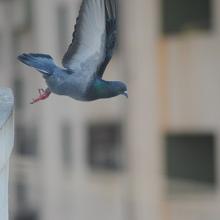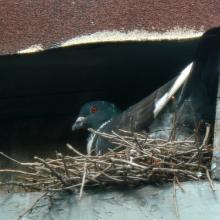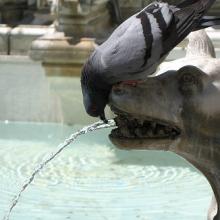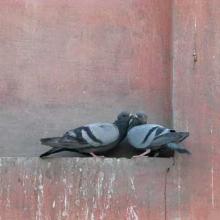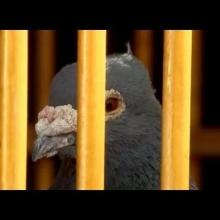

Join BirdNote tomorrow, November 30th!
Illustrator David Sibley and actor H. Jon Benjamin will face off in the bird illustration battle of the century during BirdNote's Year-end Celebration and Auction!
Though some might see them as winged rats in today’s cities, pigeons have a long-standing bond with people -- especially in our urban environment. From Mesopotamia, 7000 years ago, to the urban skyscrapers of today, pigeons have been a constant. They’ve served as meat and sacrifices, navigators and messengers, racers, hobby supplies and even science experiments.
BirdNote®
Pigeons Love Cities - But We Loved Them First
Written by Bob Sundstrom
This is BirdNote.
[Rock Pigeon flapping, then calling, https://macaulaylibrary.org/asset/167946961#_ga=2.4163696.1502895711.15…, 0.02-.05]
Pigeons are everywhere in our cities. But how did they get there? Short answer: we invited them.
It started in the earliest cities of Mesopotamia, 7000 years ago. Humans cultivated grain; wild pigeons came to forage. Mesopotamians encouraged pigeons to nest in man-made shelters… But they had some ulterior motives. Pigeons’ fat chicks — or squabs — were a delicacy, and adult pigeons were sacrificed to the gods.
[ Rock Pigeon calls, https://macaulaylibrary.org/asset/3891#_ga=2.25012474.1502895711.156357…, 0.04-.-08]
Early civilizations also discovered pigeons’ brilliant homing ability. The birds could point wandering ships homeward and speedily carry messages across large distances.
Pigeon racing — which is still a sport today — has ancient roots, too.
Charles Darwin bred pigeons, and pondered their inherited traits.
[Rock Pigeon flapping, https://macaulaylibrary.org/asset/167023011#_ga=2.126271821.1502895711…, 0.03-.05]
So until recently in our shared history, pigeons did all the work. Serving as meat, sacrifices, navigators, messengers, racers, hobby supplies and science experiments.
And they took readily to cities because, long before they met up with people, pigeons nested on cliffs, making them perfectly suited to building their nests on skyscrapers or tucked into the eaves of urban apartment complexes.
Though some might see them as winged rats in today’s cities, pigeons and people have a long-standing bond. Especially in our urban environment.
[Rock Pigeon calls, https://macaulaylibrary.org/asset/3891#_ga=2.25012474.1502895711.156357…, 0.04-.-08]
For BirdNote, I’m Ashley Ahearn.
###
Producer: John Kessler
Executive Producer: Sallie Bodie
Editor: Ashley Ahearn
Associate Producer: Ellen Blackstone
Assistant Producer: Mark Bramhill
Bird sounds provided by The Macaulay Library of Natural Sounds at the Cornell Lab of Ornithology, Ithaca, New York. ML167946961 recorded by P Marvin 0:05- 0:25. ML3891 by J Kimball 0:35.
ML167023011 by P Marvin 0:56 and as ambient throughout
BirdNote’s theme was composed and played by Nancy Rumbel and John Kessler.
© 2020 BirdNote February 2020 / March 2023
Narrator: Ashley Ahearn
ID# ROPI-06-2020-2-21 ROPI-06
Primary source: https://www.livescience.com/63923-why-cities-have-so-many-pigeons.html
Also: http://mentalfloss.com/article/54844/history-pigeon
https://www.allaboutbirds.org/guide/rock_pigeon/lifehistory




